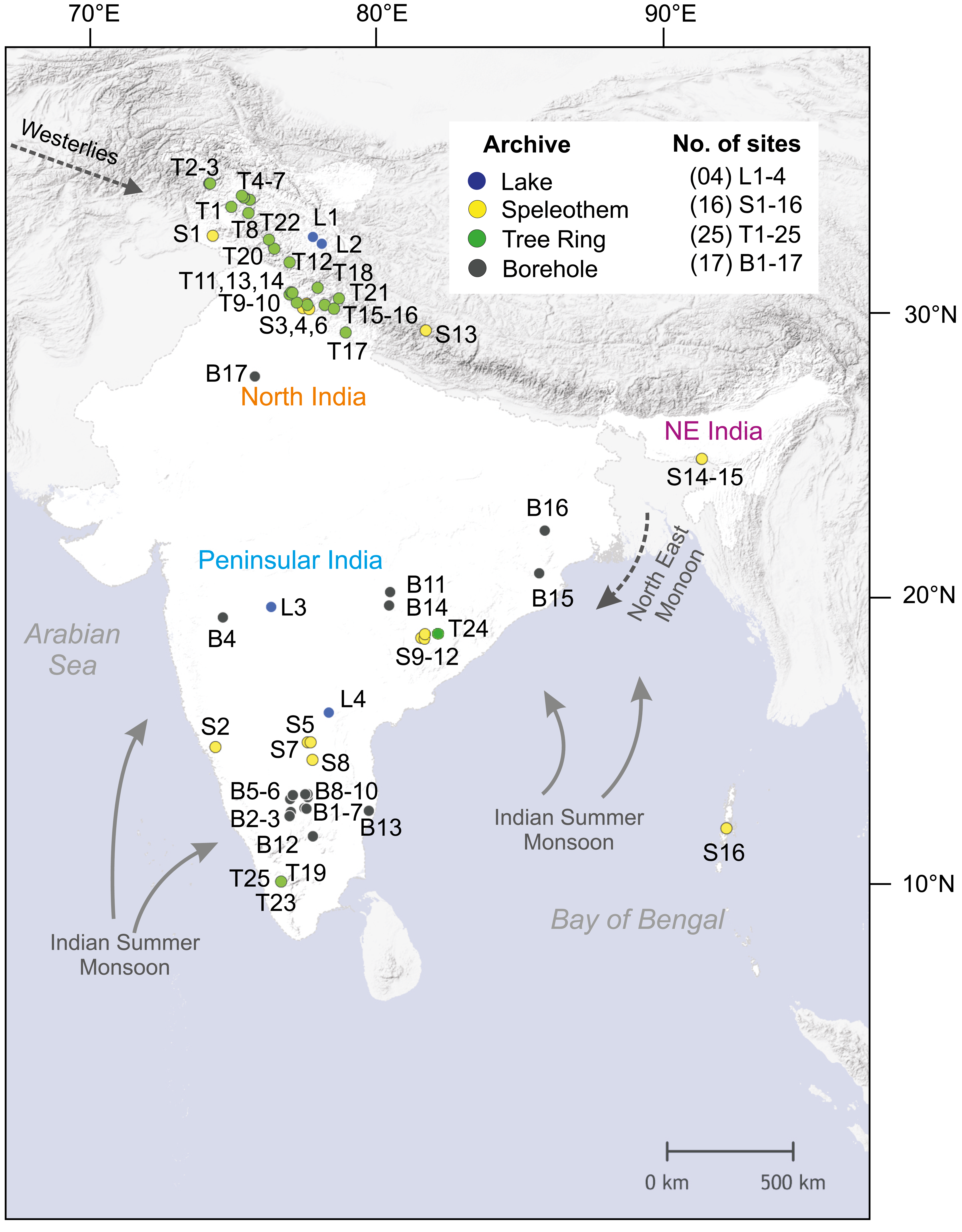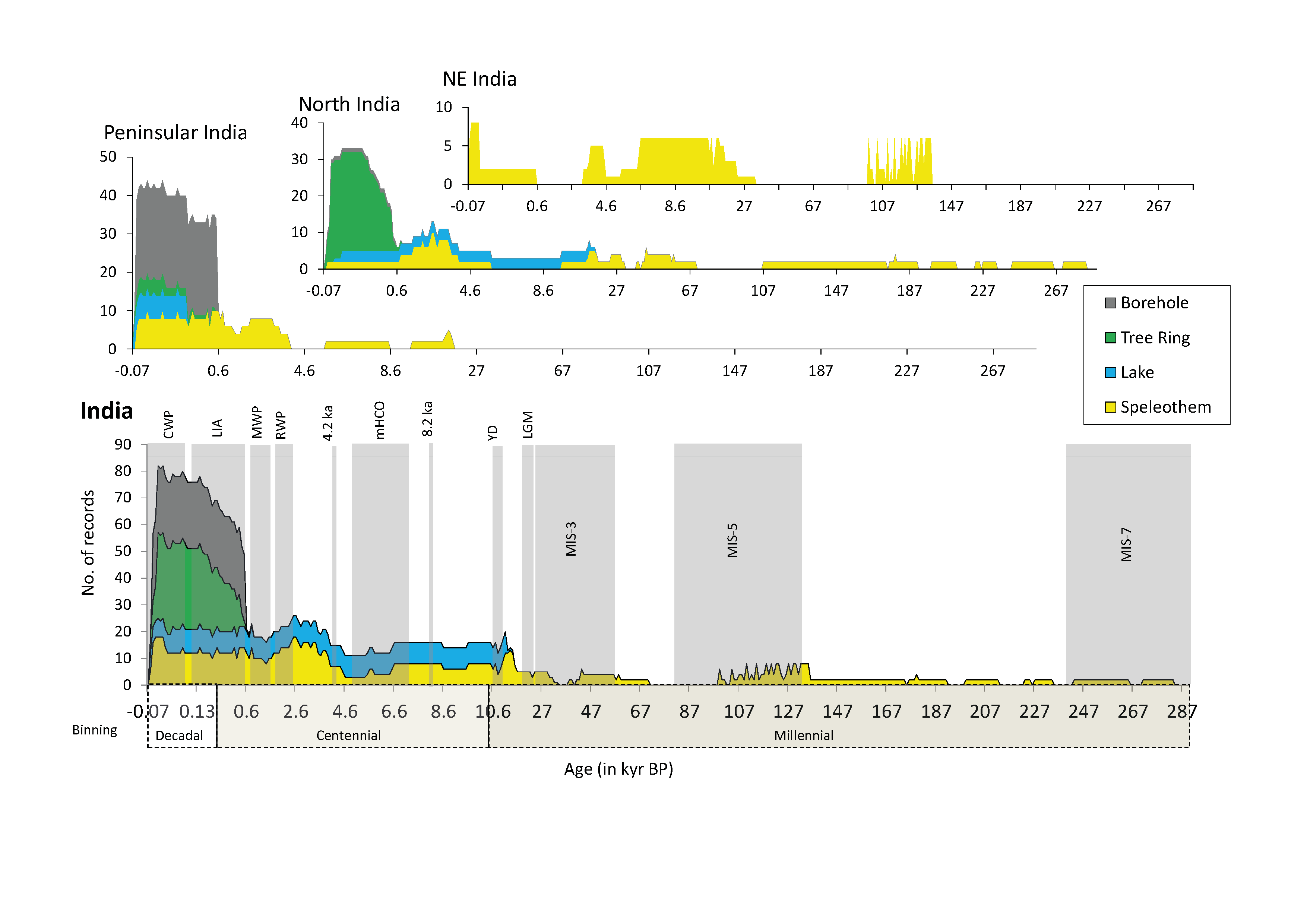- Home
- Publications
- PAGES Magazine
- Data-based Evaluation of Paleoclimate Records From The Terrestrial Indian Region: Opportunities and Gaps
Data-based evaluation of paleoclimate records from the terrestrial Indian region: Opportunities and gaps
Kaushal N, Kulkarni Y, Srivastava P, Rawat S & Managave S
Past Global Changes Magazine
29(1)
50-51
2021
Speleothem, tree-ring, and borehole archives represent the majority of publicly available proxy data from the terrestrial Indian region for investigating local climatic responses to past global circulation changes. Increasing access to data from lake-sediment archives will open new opportunities for climate research in this region.
A case for data
In the last decade, the paleoclimate field has made tremendous progress in the domains of statistical analysis of regional- to continental-scale proxy data (Tardif et al. 2019), numerical modeling (Owen et al. 2018), and data-model comparisons (Comas-Bru et al. 2019) to gain a better understanding of the processes driving climate and to improve future climate predictions. However, these analyses are only possible if data are made available by the initial data generators in supplementary information sections of published articles or in online data repositories. Synthesizing data from these different sources for regional- to continental-scale data analysis then requires further data wrangling, which is estimated to consume 80% of researcher time in some scientific fields (Dasu and Johnson 2003). The NOAA, PANGAEA, and Neotoma repositories and PAGES working groups address this issue by standardizing and, in some cases, synthesizing data. Here, we examine proxy data from the terrestrial Indian region available from the aforementioned sources and suggest the best ways to access data. We show gaps between data that have been measured but are not yet available, which will require an archive-specific, community-based effort. We highlight data that are available and should be considered for future comprehensive data-based analysis.
 |
|
Figure 1: Spatial distribution of paleoclimate records from the terrestrial Indian region available in NOAA, PANGAEA, and Neotoma repositories and made available by PAGES working groups. Detailed information of archives, records and sources are given in the table hosted at https://doi.org/10.5281/zenodo.4292977. |
Distribution of accessible terrestrial Indian paleoclimate data
The terrestrial Indian region has been geographically divided into north, northeast, and peninsular subregions, which have distinct sources of moisture and climates (Fig. 1). Paleoclimate records in databases and repositories are available from speleothem, lake, tree-ring, and borehole archives. North and peninsular India have a high density of paleoclimate records from multiple archives. Northeast India has only speleothem records. Records from the central Indian Indo-Gangetic plain are conspicuously lacking. The geologically oldest proxy records are from speleothems, with the north Indian Bittoo cave record extending intermittently to ~280,000 years before present (Fig. 2). Most of the remaining speleothem records from all three regions cover the last ~30,000 years. Lake records cover the last ~15,000 years, while tree-ring and borehole records cover the last ~500 years.
The NOAA repository hosts the highest number of tree-ring standard-growth index and isotope records, all borehole records (which are part of a single study), and a few speleothem stable isotope and trace element records (Table 1). The highest number of speleothem oxygen and carbon isotopic proxy records with standardized data and metadata have been made available by the PAGES working group Speleothem Isotope Synthesis and AnaLysis (SISAL) as sql and csv files. Lake records can be found in the PANGAEA and Neotoma repositories. Many speleothem, tree-ring, borehole, and lake records covering the last 2000 years have been made available by the PAGES 2k Network with extended data and metadata in different formats in the NOAA repository and in FigShare.
| Data Source | Archive | No. sites | No. Entities | No. Proxy Records | Data access |
| Neotoma | Lake | 1 | 1 | 1 | Neotomadb https://www.neotomadb.org/ > Database Explorer > Scroll map to India > Advanced Search > Search by geopolitical unit> India |
| NOAA | Speleothem | 6 | 15 | 33 | NOAA https://www.ncdc.noaa.gov/paleo-search/ > Data type: speleothems > Advanced Search > Locations > Continent > Asia > Southcentral > India |
| Tree ring | 24 | 31 | 31 | NOAA https://www.ncdc.noaa.gov/paleo-search/ > Data type: Tree ring> Advanced Search > Locations> Continent > Asia > Southcentral > India | |
| Borehole | 17 | 17 | 17 | NOAA https://www.ncdc.noaa.gov/paleo-search/ > Data type: Borehole> Advanced Search > Locations> Continent > Asia > Southcentral > India | |
| PAGES | Speleothem | 16 | 38 | 75 | PAGES http://pastglobalchanges.org/ > Data: databases > SISAL |
| PANGAEA | Lake | 3 | 3 | 8 | PANGAEA https://www.pangaea.de/ > All Topics > India |
| Speleothem | 1 | 1 | 2 | PANGAEA https://www.pangaea.de/ > All Topics > India | |
|
Table 1: Data accessibility in NOAA, PANGAEA, and Neotoma repositories and made available by PAGES working groups. Each entity indicates the individual lake-core/speleothem/borehole/tree-ring master chronology, and the proxy record indicates a measurement that can be used individually to provide climatic/environmental information (for example, oxygen isotopes, tree ring standard growth index, palynology). |
|||||
Opportunities and gaps
Speleothem oxygen isotopic records provide sub-decadal- to millennial-scale information of past circulation and monsoon conditions from the terrestrial Indian region (Kaushal et al. 2018). They can be used for isotope-enabled climate model-data comparisons to improve our process-based understanding of controls on the monsoon (Battisti et al. 2014) and increase confidence in the ability of climate models to predict future changes (Schmidt 2010). As of yet, only very limited spectral analysis of existing oxygen and carbon isotopic records from the terrestrial Indian region has been performed to identify sub-decadal- and decadal-scale monsoon patterns (Midhun et al. 2020). Similarly, speleothem carbon isotopic and trace element records are increasingly being used to understand past changes in local climatic and environmental conditions in regions around the globe (Fairchild and Treble 2009; Fohlmeister et al. 2020); however, there are currently few measurements of trace elements or analysis of these proxy data from the Indian region.
Tree-ring growth indices produced from conifer and teak trees provide the highest resolution information of terrestrial climate in India. Tree-ring data are useful for continental-scale reconstruction and analysis of past droughts and temperatures (Cook et al. 2010; PAGES2k Consortium 2017). Millennium-long tree-ring chronologies developed in the terrestrial Indian region (Yadav et al. 2011; Yadav 2013) offer an opportunity to decipher centennial-scale climate variability and to understand prevailing climate during important phases such as the Medieval Warm Period, Little Ice Age, and Current Warm Period. The scarcity of trees with annually resolved tree rings is one of the main reasons for having only a few tree-ring datasets from peninsular India (Fig. 1). A "tree ring" defined based on the seasonality in the isotopic record of trees (Evans and Schrag 2004) could provide the necessary chronology to reconstruct past climate using trees lacking discernible growth rings. Such analysis can be used to decipher past variability in the frequency and intensity of the dry spells during monsoons (Managave et al. 2010), and in simultaneously reconstructing southwest and northeast monsoonal rainfall (Managave et al. 2011).
Lake sediments provide archives of regional to global climate change. Continuous sedimentation allows climatic variability to be assessed over several millennia through analysis of organic (e.g. pollen, carbon isotopes, total organic carbon, lipid biomarkers, diatoms) and inorganic (e.g. grain size, elemental chemistry, environmental magnetism; e.g. Rawat et al. 2015a, b; Sarkar et al. 2015) proxies. India hosts many natural lakes extending from the high-altitude alpine Himalayan regions to the tropical peninsula. Because most Indian lakes are non-varved and receive low sedimentation, they can provide semi-quantitative rainfall estimates only at centennial resolution. More than 76 lake records from India have been analyzed in the literature (Misra et al. 2019); however, as of yet only nine proxy records from four lakes have been made available in databases and repositories. A paleolimnological community-based effort is required to both produce new data from India's many lakes and increase the availability of previously collected lake-sediment records.
Summary
Our analysis suggests that paleoclimate work in the Indian region can be improved by (1) increasing the number and accessibility of lake-sediment records region-wide, (2) generating data from records that extend beyond the last 15,000 years, and (3) generating data from geographically under-represented subregions, such as the central Indian Indo-Gangetic plain. Combining information across the diverse proxy records in the repositories and databases will provide opportunities to assess factors influencing major moisture drivers and mechanisms associated with westerlies and the Asian monsoon system.
acknowledgements
PS acknowledges funding from FAPESP Postdoctoral grant 2019/11364-0.
affiliations
1Asian School of the Environment, Nanyang Technological University, Singapore
2Department of Civil Engineering, Gharda Institute of Technology, Ratnagiri, India
3Instituto Oceanográfico, Universidade de São Paulo, Brazil
4Wadia Institute of Himalayan Geology, Dehradun, India
5Indian Institutes of Science Education and Research, Pune, India
contact
Nikita Kaushal: nikitagelogist gmail.com
gmail.com
references
Battisti DS et al. (2014) J Geophys Res Atmos 119: 11-997
Comas-Bru L et al. (2019) Clim Past 15: 1557-1579
Cook ER et al. (2010) Science 328: 486-489
Dasu T, Johnson T (2003) Exploratory Data Mining and Data Cleaning John Wiley & Sons, 203 pp
Evans MN, Schrag DP (2004) Geochim Cosmochim Acta 68: 3295-3305
Fairchild IJ, Treble PC (2009) Quat Sci Rev 28: 449-468
Fohlmeister J et al. (2020) Geo Cosmo Acta 279: 67-87
Kaushal N et al. (2018) Quaternary 3: 29
Managave SR et al. (2010) Geophys Res Lett 37: L05702
Managave SR et al. (2011) Clim Dyn 37: 555-567
Midhun M et al. (2020) Geophys Res Lett: 47, e2020GL089515
Misra P et al. (2019) Earth-Sci Rev 190: 370-397
Owen R et al. (2018) Comput Geosci 119: 115-122
PAGES2k Consortium (2017) Sci Data 4: 170088
Rawat S et al. (2015a) Quat Sci Rev 114: 167-181
Rawat S et al. (2015b) Palaeogeogr Palaeoclimatol Palaeoecol 440: 116-127
Sarkar S et al. (2015) Quat Sci Rev 123: 144-157
Schmidt GA (2010) J Quat Sci 25: 79-87
Tardif R et al. (2019) Clim Past 15: 1251–1273
Yadav RR (2013) J Geophys Res Atmos 118: 4318-4325
Yadav RR et al. (2011) Clim Dyn 36: 1545-1554
links
PAGES2k Consortium (2017):
NOAA: https://www.ncdc.noaa.gov/paleo/study/21171
FigShare: https://figshare.com/collections/A_global_multiproxy_database_for_temperature_reconstructions_of_the_Common_Era/3285353
SISAL database v2.0: researchdata.reading.ac.uk/256/
NOAA repository: https://www.ncdc.noaa.gov/data-access/paleoclimatology-data/datasets
PANGAEA repository: https://pangaea.de/
Neotoma database: https://www.neotomadb.org/
SISAL working group: pastglobalchanges.org/sisal
PAGES 2k Network: pastglobalchanges.org/2k

